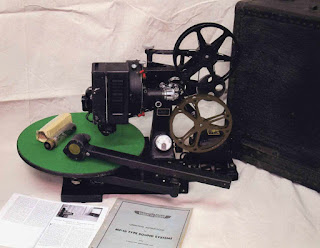Please turn in your silent film analysis (see previous homework assignments!)
Joseph P. Maxfield (AT&T’s Bell Laboratories) invented the first phonograph linked to film (licensed by Victor as the Orthophonic Victrola) which became the basis for the
Vitaphone sound-on-disc system.
The Vitaphone allowed actors to lipsync their performance while the sound was recorded after; (This helped to popularize animation!) An example is from the very young Disney Studios: Steamboat Willie (1928. The first Mickey Mouse cartoon--based on Buster Keaton's Steamboat Bill).
The first sound film was Don Juan in 1926. The Jazz Singer (cantor); The Jazz Singer (1927), directed by Alan Crosland, starring famous vaudeville actor, Al Jolson is popularly given this award. Really both films were songs (or just music in Don Juan's case) that were played along like a record as sound was synched with the film. The Jazz Singer gave birth to the Hollywood musical genre.
Warner Bros. and Fox Film began wiring their theaters for sound as early as 1926. By 1928, Western Electric developed a sound-on-film system, which later developed a new competitive major studio: Radio-Keith-Orpheum or RKO.
The conversion to sound created both positive and negative effects for film:
Positive:
Hal Roach was born in Elmira, NY (near us!), before moving to Hollywood. He worked for the Pathe Exchange Co. before working for MGM (Metro-Goldwyn-Mayer) as a producer. He is best known for producing the comedy teams of Laurel & Hardy and The Our Gang comedies (or Little Rascals).
Laurel and Hardy
Not all silent film stars made the transition to talkies. One comic duo that did, however, was Stan Laurel and Oliver Hardy. This iconic duo made over 100 films together, initially short films, before expanding into feature length films by the end of the 1930s. More can be examined by clicking on the link of their name above. Here are a few clips/films:
HOMEWORK: Please read the chapter on "Sound in Film". Complete the graphic organizer for participation credit. Watch any of the shorts or feature films above. Note how diegetic and non-diegetic sound is used with the new technology from the golden age of film.
The Invention of Sound in Film
Joseph P. Maxfield (AT&T’s Bell Laboratories) invented the first phonograph linked to film (licensed by Victor as the Orthophonic Victrola) which became the basis for the
Vitaphone sound-on-disc system.
The first sound film was Don Juan in 1926. The Jazz Singer (cantor); The Jazz Singer (1927), directed by Alan Crosland, starring famous vaudeville actor, Al Jolson is popularly given this award. Really both films were songs (or just music in Don Juan's case) that were played along like a record as sound was synched with the film. The Jazz Singer gave birth to the Hollywood musical genre.
Warner Bros. and Fox Film began wiring their theaters for sound as early as 1926. By 1928, Western Electric developed a sound-on-film system, which later developed a new competitive major studio: Radio-Keith-Orpheum or RKO.
The conversion to sound created both positive and negative effects for film:
Positive:
A. Led to a revival of national film elsewhere in the worldNegative:
B. Cinema owners did not have to hire musicians for an in-house orchestra
C. Silent films were easier to distribute across the world (no need to translate) which later creates the need for dubbing (1932 -- ex. Paramount studios); before this, multi-lingual films make stars like Marlene Dietrich, Maurice Chevalier, Bela Lugosi, Ingrid Bergman, Greta Garbo, and Peter Lore more important--since they can speak different languages (and therefore sync their voices to film).
D. Film became a single media event
E. Films came to the theatres as final products, whole and complete
F. The immersive qualities of film and the viewer become inseparable
G. Dialogue became a necessity to tell the plot of a film
A. Produced panic and confusion in HollywoodSound Film Comedian Stars
B. Many musicians lost their jobs
C. Early sound films from America were boycotted by certain countries; films were not as widely distributed, more costly to translate.
D. Silent film culture was destroyed
E. Films did not require additional music, some ambiance was lost -- sound film was seen as the killer of “film as the seventh art form”
F. Film was no longer a “theatrical” or “artistic” event
G. Dialogue became a necessity to tell the plot of a film
Hal Roach was born in Elmira, NY (near us!), before moving to Hollywood. He worked for the Pathe Exchange Co. before working for MGM (Metro-Goldwyn-Mayer) as a producer. He is best known for producing the comedy teams of Laurel & Hardy and The Our Gang comedies (or Little Rascals).
Laurel and Hardy
Not all silent film stars made the transition to talkies. One comic duo that did, however, was Stan Laurel and Oliver Hardy. This iconic duo made over 100 films together, initially short films, before expanding into feature length films by the end of the 1930s. More can be examined by clicking on the link of their name above. Here are a few clips/films:
- The Music Box (1932) Winner of the Academy Awards for Best Short Subject
- Sons of the Desert (1933) clip/trailer
- Babes in Toyland (1934) clip/trailer
- Way Out West (1937) (clip/song)
- The Flying Deuces (1939) (full film)
- Nothing But Trouble (1944) (trailer/clip)
- Utopia (1951) (full film)
- Honkey Donkey (1934)
- Spooky Hooky (1936)
- The Pinch Singer (1934)
- Mama's Little Pirate (1934)
- Free Eats (1932)
- Readin' & Writin' (1932)
- Mush n Milk (1933)
- Little Rascals (Greatest Hits, 1)
HOMEWORK: Please read the chapter on "Sound in Film". Complete the graphic organizer for participation credit. Watch any of the shorts or feature films above. Note how diegetic and non-diegetic sound is used with the new technology from the golden age of film.



No comments:
Post a Comment